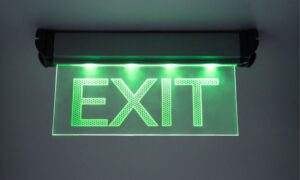
When an emergency strikes in your commercial or industrial building, every second counts. Fires, power outages, and other unexpected events can put your employees and property at risk. As part of your overall life safety solutions, well-designed emergency lighting guides everyone to safety. Today we will talk about the essentials of emergency lighting for your building.
Make sure you are equipped for any emergency scenario. At Wilson Fire Equipment, we are your trusted source for life safety solutions in Houston. We can help you design and install the perfect emergency lighting system for your building.
What Kind of Emergency Lighting Do You Need?
Different situations call for different types of lighting. Here’s a quick breakdown:
Escape Lighting: This is the most common type. It illuminates escape routes, like hallways and stairwells, guiding people towards exits. Think of bright exit signs and the lights that activate when the power goes out.
These systems are essential for safe and orderly evacuations. They must meet strict standards, like those set by the National Fire Protection Association (NFPA), to ensure they’re up to the task.
Standby Lighting: Imagine a hospital operating room during a power outage. Standby lighting keeps critical areas functioning. It can also power security systems or other essential equipment, preventing disruptions and ensuring safety.
Emergency Lighting for High-Risk Tasks: Some jobs require special attention, even under normal conditions. In industrial facilities or on construction sites, emergency lighting ensures workers can safely shut down equipment or evacuate hazardous areas during an emergency. This specialized lighting helps prevent accidents and injuries when every second matters.
Optimal Lighting Setup for Life Safety Solutions
Designing an effective emergency lighting system takes careful planning. Here are the key factors to consider:
Know Your Building: A sprawling warehouse needs a different approach than a high-rise office. Consider the size and layout of your building, the type of work done there, and potential hazards specific to your industry.
Assess the Risks: Identify potential emergencies. Is fire a major concern? Are there hazardous materials on site? A thorough risk assessment helps determine the type and extent of emergency lighting needed.
Light the Way: Emergency lights must be bright enough to guide people safely. Standards like those from the Illuminating Engineering Society (IES) provide minimum light levels (lux) for different areas. Ensure your system meets these requirements for optimal visibility during an evacuation.
Strategic Placement: Think about where people will be and where they need to go. Place lights along escape routes, at exits, and in open areas. Consider obstructions, ceiling height, and the overall flow of people during an emergency.
Connect with Fire Alarms: Integrating your emergency lights with your fire alarm system ensures they activate automatically when an alarm sounds. This saves precious time and ensures a coordinated response during an emergency.
Maintenance and Testing Keeps Your Systems Ready and Reliable
Installing an emergency lighting system is just the first step. To ensure it’s always ready when you need it, ongoing maintenance is crucial. Schedule routine inspections and tests, including simulated power outages, to ensure everything works correctly. This helps identify faulty components, like burned-out bulbs or weak batteries, before they become a problem.
Most emergency lights rely on batteries to function during a power outage. These batteries have a limited lifespan and need to be replaced regularly. Follow manufacturer recommendations for replacement schedules and proper disposal.
Maintain detailed records of all inspections, tests, and maintenance activities for all components of your life safety solutions. This documentation proves your commitment to safety and helps you track the system’s performance over time. Plus, this helps prove you are staying compliant with required safety regulations.
Life Safety Solutions Customized for Your Business
Need help navigating the complexities of life safety systems such as emergency lighting? Contact Wilson Fire Equipment today. We’ll work with you to design and install tailored life safety solutions that meet your specific needs and ensure your building is prepared for any emergency.
